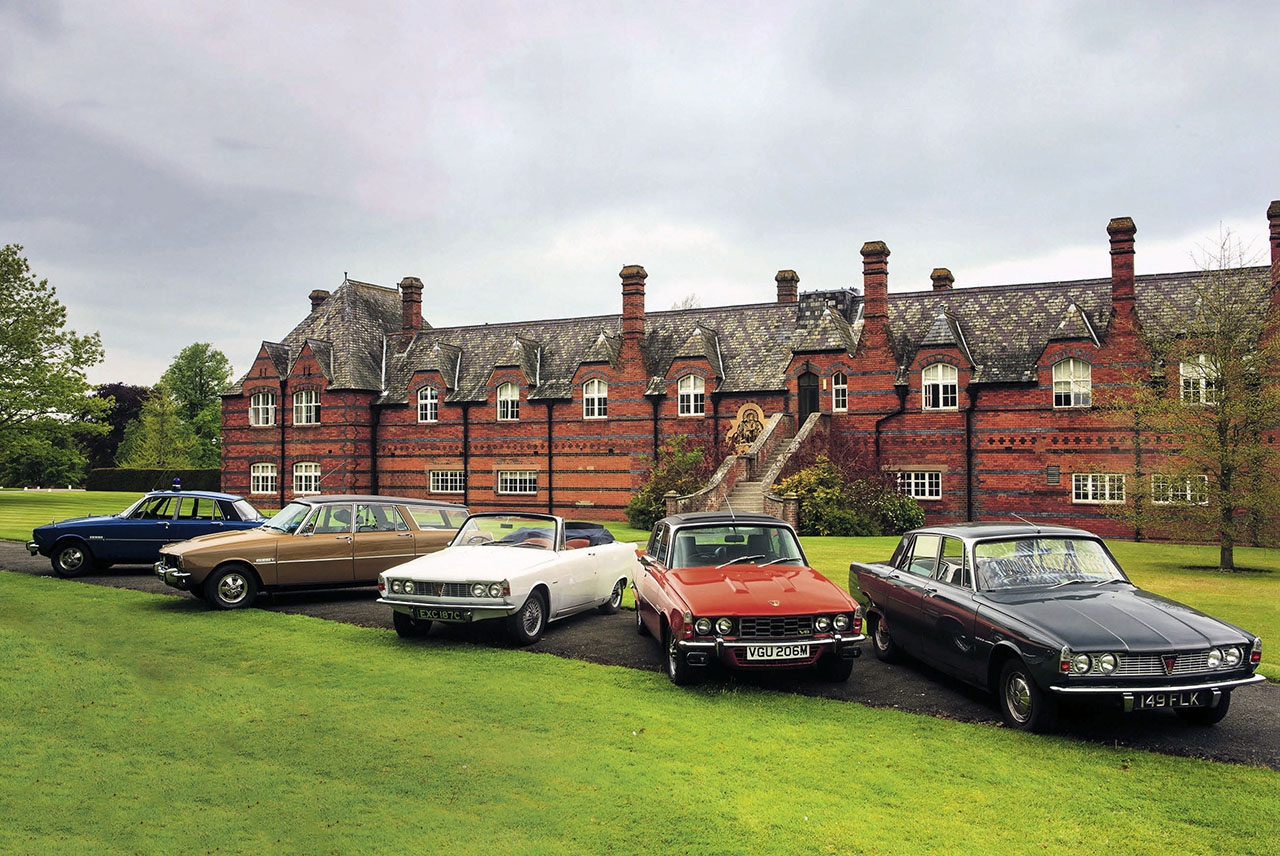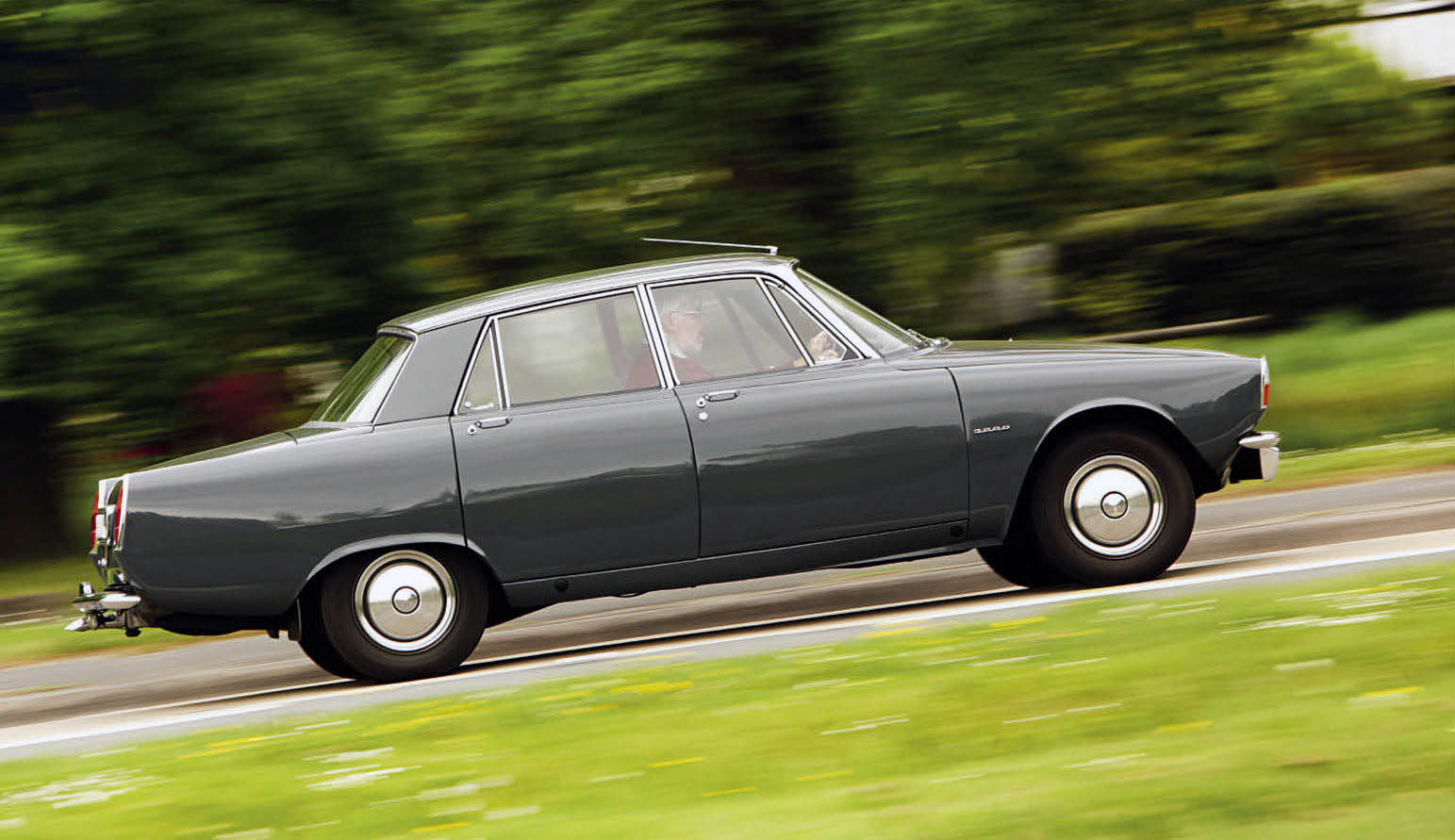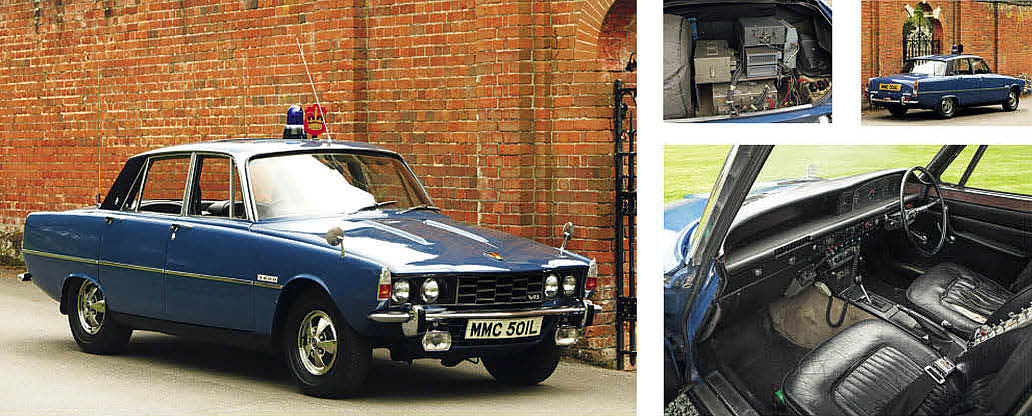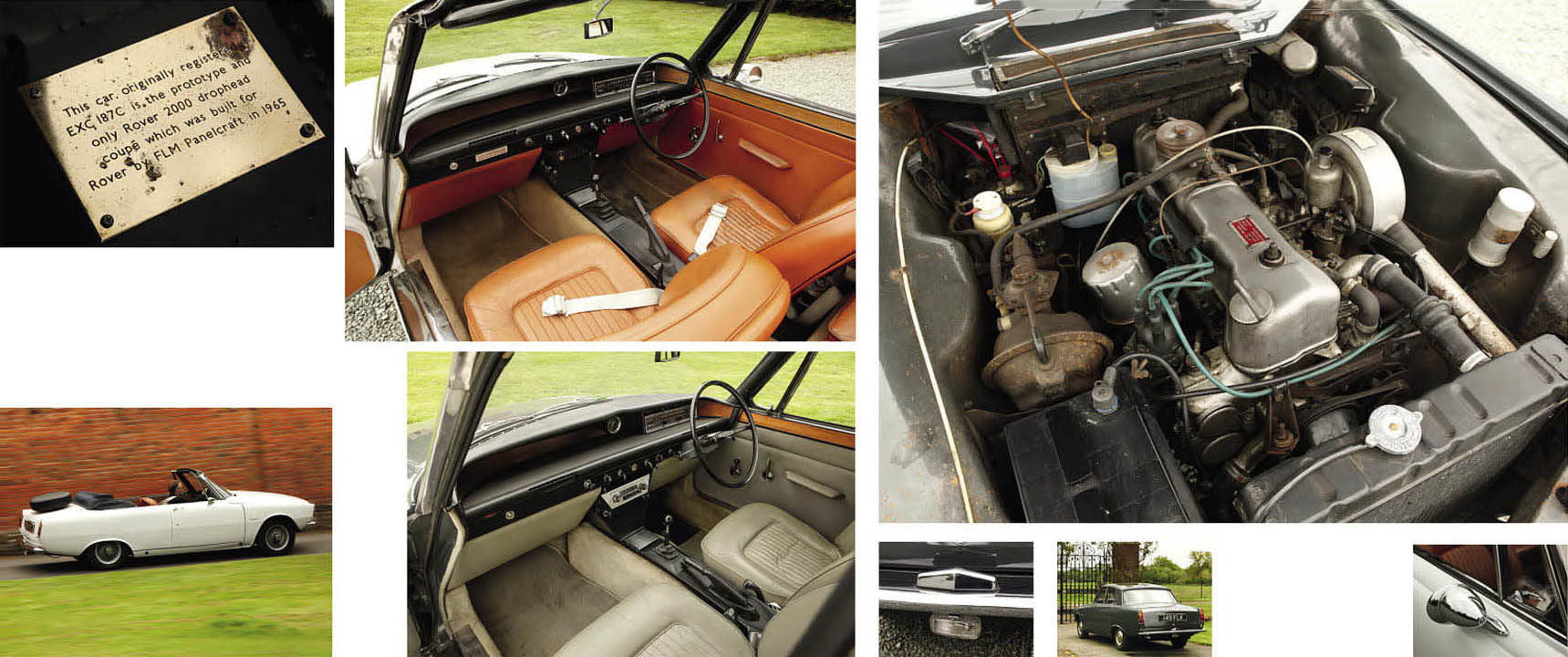
Avant-garde, à la Solihull Rover P6 at 53. The West Midlands’ answer to the DS. The P6 may not look as wild as a Citroën DS but, argues Andrew Roberts as he surveys this stunning set, it was as radical a design for Rover when it was launched in 1963. Photography Tony Baker.
When the Rover 2000 was officially introduced on 9 October 1963, its sheer audacity caused devotees of the marque to drop their driving gloves. David Bache’s styling gave the car the impression of being in motion even when it was stationary and its panels were bolted on to a monocoque punt, in Citroën DS fashion. It had disc brakes all round, a facia devoid of walnut veneer and a de Dion rear axle. Most radically of all, the 2000 was more than 8in lower than the P4 and, in the words of a ’68 road test: ‘It was the first post-war Rover in which the average owner would not be able to wear a hat while driving!’
The origins of the 2000 date back to 1957, when Rover’s management decided that the P4’s replacement would have to appeal to the enthusiastic motorist and reflect post-war social changes. Bache and his team were commissioned to style the exterior and initially intended the P6 to have a front end akin to the DS, although this did not find favour with the directors. The high tooling costs meant that the P6’s projected life was at least 10 years and this called for ‘timeless’ as opposed to ‘controversial’ styling.

Another plan was for the P6 to be powered by a gas turbine –hence its unorthodox horizontal front springs –but that idea was eventually abandoned and the 2000 was powered by a new overhead-cam engine with a Heron ‘bowl-in-piston’ head design to fit under the low bonnet.
The Studebaker-inspired lines of the original ‘Cyclops’ P4 had caused quite a stir, but Rover made almost all of its rivals look like relics from the previous decade with the P6. The Humber Hawk was as sensible as a mug of Horlicks, while the undeniably handsome Wolseley 6/110 was almost as conservative in image. The Ford Zodiac MkIII and Vauxhall Cresta PB both made their debuts in 1962, although these were cars for provincial businessmen who wanted softly sprung Anglo-American cruisers.
The epic sales film Assignment P6 established the 2000’s appeal to “modern go-ahead motorists… discerning people with a bit of dash”, as the velvet voice of John Carson intoned, the better to reassure those dealers who were still wary at the idea of selling a significant new Rover that was powered by a mere four-cylinder engine. The featured 1963 2000 is one of the original P6 press fleet and, in its completely unadorned form, it is still the ideal transport for the affluent driver who affected Jean-Luc Godard glasses in coffee bars and who thought of cars in terms of theBMW1500, Citroën DS or Lancia Flavia.
Rover had previously attempted a middle management model with the P4 60, but that made the marketing error of being a strippedout 75. The 2000, however, appealed to drivers who might have regarded the P5 3 Litre and, whisper it, the JaguarMk22.4 as cars for an older generation. The only other home-grown executive transport they could have considered was the sporty new Triumph 2000, which packed a twincarb ‘six’ but didn’t look as fresh as the Rover. The P6’s interior mirrors the understated brilliance of the coachwork, with careful planning evident in every detail –from the adjustable steering and reclining front seats to the ergonomic layout of the dashboard. The cabin of a contemporary Humber orWolseley was more like a headmaster’s study circa 1937, but the P6’s four leather-trimmed buckets were as emblematic of a new world as Kinneir and Calvert’s road signs and learning how to make Caneton à l’Orange from Len Deighton’s Cookstrips.
Rover was constantly experimenting with the P6 during the 1960s and the inspiration for the 2000 convertible was the P5 drophead made by FLM Panelcraft. This so Captivated Rover head of design and engineering Peter Wilks that he commissioned a works soft top P6, after rigidity tests were carried out on a roofless 2000 with its back doors welded shut. For the factory version, the rear wings and doors were lengthened, the B- and C-pillars repositioned, plus the ’screen pillars were injected with molten aluminium to reduce potential vibration. The car was fitted with a smaller petrol tank to accommodate the hood and diagonal bracing struts were placed alongside the rear seat.
Whenthe 2000 Drophead Coupé was finished in July 1965,Wilks was impressed enough to use it as his personal transport, but its potential as a production model was limited by a lack of factory capacity and the sheer cost of conversion. This is a matter for great regret because the soft-top is a tantalising reminder of how the Rover could have been an alternative to the DS Décapotable as transportation for the La Dolce Vita set. If the 2000 convertible had entered full-scale manufacture, it would inevitably have been ruinously expensive – butwhocould have resisted the lure of the Mercedes-sourced blue mohair hood with West of England cloth headlining and the wire wheels? Indeed, blend the Bache styling, superb ride, sporting manners and well-balanced steering with the finely executed metalwork and you have a car very much in the Alvis tradition.
A further point of interest with the drophead is that the original engine was removed and went into Ann Hall’s rally P6. It was replaced by a prototype 2.2-litre ‘four’, which would not be fitted to standard cars until the 2200 of late 1973. Greater performance was an early concern of Rover dealers, partially allayed by the twin-carb TCof ’66, but the P6’s low bonnet line ruled out fitting the P5’s ‘six’. After various experiments with six- and even five-cylinder engines, the P5B – launched in September 1967 and powered by an ex-BuickV8– firmly signalled the P6’s future. Rover announced later that year that the 3.5-litre unit would ‘form the basis of our engine family for the next 10 years at least’ and unveiled the P6 Three Thousand Five in April ’68.
Two years after that the range was facelifted as the P6B, whose black plastic honeycomb grille marked the end of the 1960s as definitely as the break-up of The Beatles and hitherto sane businessmen suddenly adopting Jason King hairstyles. The 3.5-litre cars featured here are all variations of the second-generation P6 and the second-rarest of this trio is the 3500 Estoura. In 1967, FLM Panelcraft had created a coachbuilt five-door version of a ’66 TC. The Estoura was initially marketed by Crayford, then by Hurst Park Automobiles (which helped to design the estate) and byHROwen after 1970.
About 150-160 saloons were converted either from new vehicles or older cars; regulations of the day meant that, if the P6 was more than a year old, the cost of the alteration was tax-free. The work on the bodyshells was carried out by FLM or subcontracted to Crayford, with the saloon’s pillars and roof being replaced by a new sloping top before the cabin was refitted. But no one saw fit to apply proper rustproofing during this process, hence the Estoura’s survival rate was not helped by the estate body being fitted on top of the boot’s drainage channels.
Most Estouras were based on V8-engined P6s, because the extra weight of the estate body left the four-cylinder cars rather underpowered (and undercut by factory-built alternatives). The conversion cost a steep £800 and boasted limited load capacity against the Ford Granada Mk1 or Triumph 2.5PI Mk2 estates. Yet this is to misinterpret the Estoura’s essential appeal; there is sufficient space for a brace of pheasants.To look at our 1974 example is to imagine a landowner of the Alan Clark school of tact and diplomacy driving an Estoura at speed around his property, a 1961 Château Latour being waved out of the open driver’s window and curses being aimed at those who had bought their own furniture.
Apolice 3500 was a rather more familiar sight, with the Rover’s popularity as both traffic and area car being reflected in countless films and television productions.We particularly recommend the Austin Maxi versus P6 chase in the horror flick Deadly Strangers. Each force had its own requirements, which could have included a second fuel tank, uprated suspension, Chubb locks, anti-roll bars, high-compression heads or even a concealed firearms safe.
‘Our’ 1973 police Rover can often be seen in archive footage of 10 Downing Street during the Margaret Thatcher era. It was commissioned by The Home Office for VIP and Royalty protection duties and served as a support vehicle to the then Prime Minister. The P6B’s overall weight was raised to nearly two tons thanks to the armour plating of the body, the floor was ‘bombproof’ and there was a smaller, dished steering wheel to accommodate the driver’s knuckles when the Rover was fitted with inch-thick glass.
The 3500 was designed to afford its occupants protection from chemical attack and the primitive form of air-conditioning was essential in summer. There was also a sliding roof that was large enough to serve as an escape hatch. The Rover was used by Special Branch for high-security close protection, so the vast array of wireless equipment in the boot allowed the radio operator to tune in to different police frequencies across the UK.
Beneath the bonnet were the two-note air horns and the gong known as ‘Big Ben’. In the 1970s, cars of the London Metropolitan Police were often fitted with both forms of warning – and there was a crest that was attached to the roof only when the 3500 was escorting Royalty. The P6 was in service for a full 14 years – the Home Office wanted to derive maximum value for money for what had been an expensive car – and it was finally retired in ’87.Today it is a prized member of the Metropolitan Police Historic Vehicle Collection in Hampton and, should it ever be recalled to duty, it would doubtless serve with utter efficiency. It’s still racking up the miles going to classic events, though, and even won a Best of Show at a meeting in Scotland.
The 3500 was initially available only with an automatic gearbox – a similarly equipped 2000 that suffered from an acute lack of performance had been listed since 1966 – but enthusiastic motorists had long clamoured for a manual transmission. In April 1971, Rover launched the 3500S, which came with a strengthened version of the 2000’s gearbox and Ambla rather than hide upholstery. The S – for ‘Synchromesh’ – could be distinguished from the standard 3500 via its alloy-lookalike wheeltrims or optional Ro Style sports wheels, its vinyl roof (that vital symbol of 1970s virility) and a palpable sense of brute force that is a world removed from the original 2000. It’s not just the P6B’s new instrument panel – packed with circular dials – or the sight of the bonnet bulges that define its character, it is the refined roar of the V8 combined with a gearshift that won’t be rushed in either direction.
Any 3500S owner using their P6 as urban transport who did not pay the £88.75 extra for the power steering (as fitted to the featured car) would soon come to regret their parsimony, but the Rover rapidly displays its virtues on the open road. The performance feels effortless and planting the gearlever gently into place allows you to derive the most from a car that seems at least a decade younger than its real age. The 3500S always rolls entertainingly but safely around corners – gripping determinedly – in the style of a pursuit in an episode of Special Branch.
The SD1 was launched in summer 1976, but the last 3500S and 2200 would not leave the production lines until March 1977. British Leyland’s seemingly devoted approach to lack of care and brand devaluation had by then resulted in many of the original young P6 drivers taking their expense accounts to Audi or Saab, but back in 1963 the Rover marque’s future had seemed utterly assured. The Land-Rover, 3 Litre and 2000 each had a unique appeal yet they were underpinned by the all-encompassing quality that the Viking badge then implied.
The P6’s significance to post-war British culture cannot be underestimated for the Rover 2000 truly captured a vital aspect of the 1963 zeitgeist. It was a car made for those Britons who welcomed the demise of National Service, who had avidly followed the saga of the Profumo Affair and who no longer greeted forms of authority with an automatic sense of deference. These were the ambitious professionals whose role model was Alan Bates in Nothing But The Best and who appreciated innovative design. For them the P6 was, quite simply, the perfect car because it did not seem to adhere to any tradition. Instead, it forged a new one.
Thanks to Paul Smith (2000); Richard Spikins (Convertible); BillWebb (Estoura); John Dorsett (police car); Nick Dunning (3500S & P6 wisdom!); Rover Sports Register (www.thersr.co.uk); Metropolitan Police Historic Vehicle Collection; Elvetham Hotel, Hants (www.elvethamhotel.co.uk)
‘ENTHUSIASTIC DRIVERS HAD CLAMOURED FOR AMANUAL 3500, AND IT FEELS EFFORTLESS’

Clockwise: V8 turned P6 into a Jag beater; Ambla was standard for the boxpleat trim, leather a rare option; all P6s ride and handle well, but they lean.

Low roofline compromised Estoura’s boot space and rear vision but made it an elegant load-lugger; few survive thanks to nil rust protection in conversion.

Police P6 is armoured and has inch-thick glass, hence dished wheel to give more room; boot is all but filled byspare and radio; crest was fitted for Royal duties.

Clockwise: period tests rated seats as best of any car; Rover had qualms over using an ohc ‘four’ but it revs freely; single, central reversing light until 1966. Chic soft-topis unique, as confirmed by FLM build plate; P6’s boot is small, hence popular top-mount option for the spare wheel; sporty bullet door mirror.
‘THE INTERIOR MIRRORS THE UNDERSTATED BRILLIANCE OF THE ROVER’S COACHWORK’
Clockwise, from above: Estoura is a rare manual; extra controls for police radio and bells; neat lamp tell-tales; individual back seats; rear quarter-lights.
ROVER 2000
Sold/number built 1963-1976/329,066 (all P6s, including 80,107 V8s)
Construction steel monocoque with bolt-on steel panels bar aluminium bonnet and bootlid
Engine iron-block, alloy-head, single-overhead- cam 1978cc ‘four’, with single SU carburettor or twin SUs (TC, from 1967-’73)
Max power 89bhp @ 5000rpm 109.5bhp @ 5500rpm
Max torque 108lb ft @ 2500rpm 124lb ft @ 2750rpm
Transmission four-speed manual or Borg-Warner Type 35 three-speed automatic, driving rear wheels
Suspension:
Front independent, by transverse lower links, leading upper links acting on horizontal coil springs, anti-roll bar
Rear coil springs, fixed-length driveshafts, stabiliser rod, de Dion sliding tube, fore/aft Watt linkages; telescopic dampers f/r
Steering Adamant Marles worm and roller
Brakes discs, inboard at rear, with servo
Length 14ft 10 ½ in (4534mm)
Width 5ft 6in (1676mm)
Height 4ft 6 ¾ in (1391mm)
Wheelbase 8ft 7 3/8 in (2626mm)
Weight 2760lb (1252kg)
Mpg 22-29
0-60mph 14.6 secs
Top speed 104mph
Price new £1264 9s 7d
Price now £20,000 (for the featured car, typically £3-5000)
2000 DROPHEAD COUPÉ
Where different to 2000
Engine 2205cc (prototype version of engine fitted to 2200SC &TC, made from 1974-1977)
Max power 98bhp @ 5000rpm 115bhp @ 5000rpm
Max torque 126lb ft @ 2500rpm 135lb ft @ 3000rpm
Height 4ft 5in (1346mm)
Weight c3200lb (1451kg)
Price now £25,000
3500S
Where different to 2000
Engine all-alloy, overhead-valve 3528cc V8, with twin SU carburettors
Max power 143bhp @ 5000rpm
Max torque 204lb ft @ 2700rpm
Steering Burman recirculating ball; optional Adwest Varamatic variable-ratio assistance
Length 14ft 11 ¾ in (4566mm)
Height 4ft 7 ¾ in (1416mm)
Weight 2868lb (1301kg)
Mpg 19-23
0-60mph 9.1 secs
Top speed 122mph
Price new £1988 13s (1971)
Price now £4-12,000
3500 ESTOURA
Where different to 3500S
Max power 144bhp @ 5000rpm
Max torque 197lb ft @ 2700 rpm
Transmission Borg-Warner Type 65 three-speed automatic
Weight c3100lb (1406kg)
Mpg 18-21
0-60mph 10.8 secs
Top speed 112mph
Price new £2700
Price now £8-12,000
3500 ‘ROYAL TYP ROTECTION’
Where different to 3500S
Weight c4400lb (1995kg)
0-60mph c12 secs
Top speed c110mph
Price now £25,000





